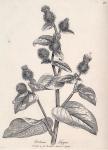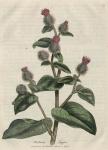
 Synonyma. Bardana. Pharm. Lond. & Edin.
Synonyma. Bardana. Pharm. Lond. & Edin.
Lappa. Hal. Stirp. Helv. n. 161.
Lappa seu Personata. Raii Hist. p. 332.
Lappa Major, Arctium Dioscoridis. Bauh. Pin. 198.
Personata. Camerar Epit. 887.
Bardana sive Lappa major. Dodon. 38. J. Bauh. vol. 3. 570.
Bardana major. Gerard, 809.
Bardana Vulgaris major, Park. 1222.
Arctium Lappa. Curt. Flor. Lond. Relhan Cant. 302. Withering. B. A. 163.
(greek) Graecor.
Varietates sic se habent, Hort. Kew. vol. 3. p. 136.
α Lappa major capitulo glabro maximo. Raii Syn. 196. Smooth-Headed Common Burdock.
β Lappa major montana, capitulis tomentosis. Bauh. Pin. 198. Wooly-headed Burdock.
Class Syngenesia. Ord. Polygamia Aequalis. L. Gen. Pl. 923.
Ess. Gen. Ch. Cal. globosus: squamis apice hamis inflexis.
Spec. Char. A. foliis cordatis inermibus petiolatis.
The root is biennial, subcylindrical, long, simple, externally of a dark brown colour, internally white, and sends off many slender fibres: the stalk is erect, roundish, grooved, villous, purplish, above an inch in diameter, three feet high, and alternately branched: the leaves are alternate, patent, heart-shaped, veiny, above of a dark green colour, underneath whitish; the lower leaves are very large, and stand upon long footstalks, which are grooved like the stem: the calyx is common to all the florets, imbricated, globular, the exterior scales are entangled in fine wooly threads, firm, elastic, and their extremities are polished and hooked; the flowers are numerous, disposed in heads, and stand alternately upon footstalks on the branches; the corolla is compound, the florets purple, tubular, each having the limb divided into five pointed segments; the stamina are five, white, and filiform; the antherae unite into a tube, are of a bluish colour, and project beyond the corolla; the germen is somewhat triangular, the styles white, and longer than the stamina, and the stigma bifid: the seeds are oblong, brown, and have irregular rough surfaces.
This plant is common in waste grounds and road sides; it flowers in July and August, and is well known by the burs, or scaly heads, which stick to the clothes, a circumstance from whence the word Lappa is supposed to be derived. [Lappa dici potest vel (greek) prehendere vel (greek) lambere. Ray, l. c.] The Pharmacopoeias direct the root for medical use: it has no smell, but tastes sweetish, and mixed as it were with a flight bitterishness and roughness. Its virtue, according to Bergius, is mundificans, diuretica, diaphoretica; [Mat Med. 653.] and many instances are upon record in which it has been successfully employed in a great variety of chronic diseases, as scurvy, rheumatism, gout, lues venerea, and pulmonic complaints. [Henricus III. Galliarum Rex, a Petro Pena decocto radicum Lappae ab hac lue sanatus fuit. Vide Reverius, Obs. 41.] We have never had an opportunity of observing the effects of this root, except as a diuretic, and in this way we have known it succeed in two dropsical cases, where other powerful medicines had been ineffectually used: and as it neither excites nausea nor increases irritation, it may occasionally deserve a trial where more active remedies are improper. The seeds also possess a diuretic quality, and have been given with advantage in the dose of a dram in calculous and nephritic complaints, and in the form of emulsion as a pectoral. The root is generally used in decoction, which may be made by boiling two ounces of the fresh root in three pints of water to two, which, when intended as a diuretic, should be taken in the course of two days, or if possible in twenty-four hours.
The young stems of this plant, stripped of their rind, are boiled and eat like asparagus. When raw, they are good with oil and vinegar. Withering, 864. l. c.

